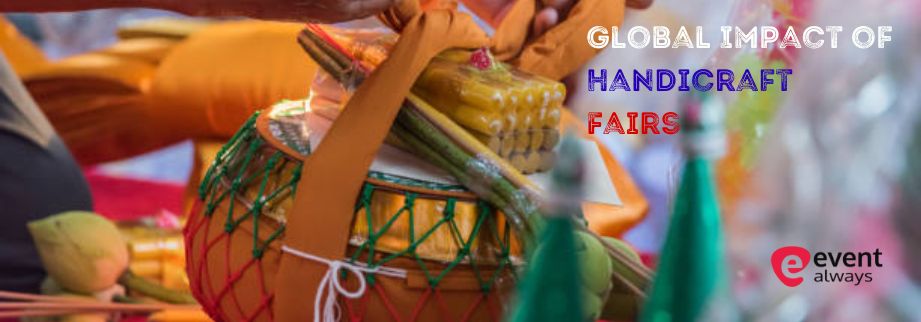We delve into the fascinating world of handicraft fairs and their profound global impact. As purveyors of artistry and cultural heritage, these fairs transcend boundaries, bringing together artisans, enthusiasts, and connoisseurs from every corner of the world. Join us on a journey of discovery as we explore the significance, reach, and transformative influence of handicraft exhibitions that leave an indelible mark on societies and economies alike.
Celebrating Cultural Exchange of handicraft fairs
Handicraft fairs are beacons of cultural exchange, where diverse traditions intertwine, fostering understanding and appreciation among different communities. Each fair becomes a microcosm of global unity, showcasing the beauty and uniqueness of cultural heritage. Attendees from various backgrounds come together, celebrating the shared love for art, craftsmanship, and the stories behind each masterpiece.
Empowering Artisans
One of the most profound impacts of handicraft fairs lies in their ability to empower artisans. These fairs provide a platform for skilled craftsmen and women to showcase their talent on an international stage. By directly connecting with customers, artisans gain financial independence and recognition for their artistry. The support garnered from such events enables artisans to sustain their traditional crafts and pass down their skills to future generations.
Safeguarding Traditional handicrafts fairs
The global impact of virtual handicraft fairs extends to the preservation of heritage. As younger generations increasingly engage with modern technology and lifestyle, traditional crafts risk fading into obscurity. However, these fairs act as guardians of cultural heritage, preserving ancient techniques and designs that would otherwise be lost to time. Through showcasing traditional crafts, handicraft fair play a crucial role in safeguarding intangible cultural heritage for posterity.
Boosting Local Economies with handicraft fairs
Handicraft fairs have a significant economic impact on local communities and economies. As visitors flock to these events, there is a surge in demand for local goods, creating a ripple effect on the surrounding economy. From transportation and accommodation to food and other goods, the influx of visitors stimulates economic activity, supporting local businesses and fostering sustainable development.
Promoting Fair Trade: Ethical Consumerism
Handicraft fairs champion fair trade principles, ensuring that artisans receive just compensation for their work. By eliminating intermediaries, these fairs empower artisans to set fair prices for their creations, ensuring that they are not exploited or undervalued. Ethical consumerism gains momentum at handicraft fair, encouraging attendees to make conscious choices and support a sustainable, transparent supply chain.
Tourism and Cultural Tourism : A Cultural Immersion
For travelers seeking authentic cultural experiences, handicraft fairs are a magnet. Tourists and cultural enthusiasts alike are drawn to these events, seeking to immerse themselves in the artistic traditions and craftsmanship of different cultures. The promotion of cultural tourism through wooden handicraft fair has a positive impact on local tourism industries, attracting visitors who seek more meaningful and interactive experiences.
Educational Opportunities : Learning from Artisans
Handicraft fairs present unique educational opportunities, where attendees can learn directly from skilled artisans. Workshops and demonstrations offer insights into traditional techniques and the creative process behind each piece. Such interactive learning experiences enrich the knowledge of visitors and perpetuate the appreciation for art and craftsmanship.
A World of handicraft fairs
The allure of handicrafts extends beyond fairs. Artisanal creations have a remarkable impact on interior design and décor trends. From handwoven textiles adorning living spaces to intricately carved sculptures that lend character to gardens, handicrafts become treasured accents that elevate aesthetics and imbue spaces with a sense of artistry.
Empowering Women for handicrafts fairs
In many cultures, handicrafts have been a domain of women, and handicraft fairs provide a platform for their economic empowerment. By showcasing their talents, women artisans gain financial independence, bolstering their role as active contributors to their families and communities. Empowering women through terracotta handicrafts fair creates a positive ripple effect, encouraging gender equality and uplifting societies as a whole.
A Renaissance of Traditions
The resurgence of interest in handicrafts and their global impact revitalizes forgotten art forms and revives dwindling traditions. As new generations take an interest in traditional crafts, ancient techniques and knowledge find new life. The socio-cultural revival brought about by handicraft fairs breathes new vigor into cultural practices and helps communities reconnect with their roots.
Promoting Inclusivity : Art Beyond Borders
Handicraft fairs transcend barriers, showcasing the universal language of art. The inclusive nature of these events brings people together irrespective of nationality, ethnicity, or background, encouraging dialogue, appreciation, and celebration of diversity.
Promoting Art Education
By introducing art to younger generations at handicraft fairs, these events promote art education and inspire future artisans. Encouraging creativity from a young age ensures the continuity of artistic traditions.
Global handicraft fairs Market Access
Handicraft fairs open doors for artisans to access global markets. These events attract buyers and enthusiasts from all corners of the world, expanding the reach of artisans’ work.

